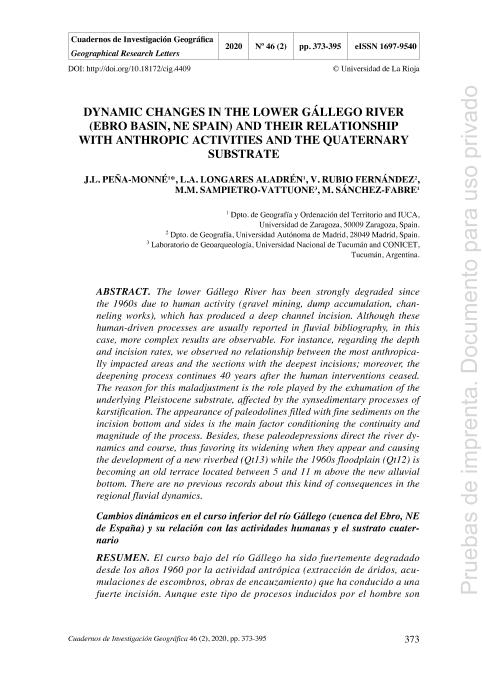Mostrar el registro sencillo del ítem
dc.contributor.author
Peña Monné, Jose Luis

dc.contributor.author
Longares Aladrén, Luis Alberto

dc.contributor.author
Rubio Fernández, V.
dc.contributor.author
Sampietro Vattuone, Maria Marta

dc.contributor.author
Sánchez-Fabre, Miguel
dc.date.available
2020-05-28T15:15:09Z
dc.date.issued
2020-04
dc.identifier.citation
Peña Monné, Jose Luis; Longares Aladrén, Luis Alberto; Rubio Fernández, V.; Sampietro Vattuone, Maria Marta; Sánchez-Fabre, Miguel; Dynamic changes in the lower Gállego River (Ebro Basin, NE Spain) and their relationship with anthropic activities and the quaternary substrate; Universidad de La Rioja; Geographical Research Letters; 46; 2; 4-2020; 373-395
dc.identifier.issn
0211-6820
dc.identifier.uri
http://hdl.handle.net/11336/106126
dc.description.abstract
The lower Gállego River has been strongly degraded since the 1960s due to human activity (gravel mining, dump accumulation, channeling works), which has produced a deep channel incision. Although these human-driven processes are usually reported in fluvial bibliography, in this case, more complex results are observable. For instance, regarding the depth and incision rates, we observed no relationship between the most anthropically impacted areas and the sections with the deepest incisions; moreover, the deepening process continues 40 years after the human interventions ceased. The reason for this maladjustment is the role played by the exhumation of the underlying Pleistocene substrate, affected by the synsedimentary processes of karstification. The appearance of paleodolines filled with fine sediments on the incision bottom and sides is the main factor conditioning the continuity and magnitude of the process. Besides, these paleodepressions direct the river dynamics and course, thus favoring its widening when they appear and causing the development of a new riverbed (Qt13) while the 1960s floodplain (Qt12) is becoming an old terrace located between 5 and 11 m above the new alluvial bottom. There are no previous records about this kind of consequences in the regional fluvial dynamics.
dc.description.abstract
El curso bajo del río Gállego ha sido fuertemente degradado desde los años 1960 por la actividad antrópica (extracción de áridos, acumulaciones de escombros, obras de encauzamiento) que ha conducido a una fuerte incisión. Aunque este tipo de procesos inducidos por el hombre son habituales en la bibliografía fluvial, en este caso se aprecian efectos más complejos. Son, por ejemplo, la profundidad y velocidad de la incisión, la falta de relación entre puntos de máxima intervención y los de mayor incisión o la continuidad del proceso cuarenta años después de cesar ese tipo de acciones. La respuesta a estos desajustes está en el papel que está jugando la exhumación del sustrato pleistoceno infrayacente, afectado por procesos sin sedimentarios de karstificación. La aparición de paleodolinas rellenas de sedimentos finos en el fondo y laterales de la incisión es actualmente el principal determinante de su importancia y continuidad. Además, estas paleodepresiones dirigen la dinámica y trazado del río y puntualmente fa- vorecen ensanchamientos laterales. Esto propicia la aparición de un nuevo lecho (Qt13) a medida que el lecho de los años 1960 (Qt12) va quedando como una terraza colgada entre 5 y 11 m sobre el nuevo fondo aluvial. No hay antecedentes de este tipo de consecuencias en la dinámica fluvial regional.
dc.format
application/pdf
dc.language.iso
eng
dc.publisher
Universidad de La Rioja
dc.rights
info:eu-repo/semantics/openAccess
dc.rights.uri
https://creativecommons.org/licenses/by-nc-sa/2.5/ar/
dc.subject
fluvial terraces
dc.subject
fluvial dynamics
dc.subject
gravel mining
dc.subject
incision
dc.subject
paleodolines
dc.subject.classification
Geografía Física

dc.subject.classification
Ciencias de la Tierra y relacionadas con el Medio Ambiente

dc.subject.classification
CIENCIAS NATURALES Y EXACTAS

dc.subject.classification
Geociencias multidisciplinaria

dc.subject.classification
Ciencias de la Tierra y relacionadas con el Medio Ambiente

dc.subject.classification
CIENCIAS NATURALES Y EXACTAS

dc.title
Dynamic changes in the lower Gállego River (Ebro Basin, NE Spain) and their relationship with anthropic activities and the quaternary substrate
dc.title
Cambios dinámicos en el curso inferior del río Gállego (cuenca del Ebro, NE de España) y su relación con las actividades humanas y el sustrato cuaternario
dc.type
info:eu-repo/semantics/article
dc.type
info:ar-repo/semantics/artículo
dc.type
info:eu-repo/semantics/publishedVersion
dc.date.updated
2020-05-27T16:32:38Z
dc.identifier.eissn
1697-9540
dc.journal.volume
46
dc.journal.number
2
dc.journal.pagination
373-395
dc.journal.pais
España

dc.journal.ciudad
Logroño
dc.description.fil
Fil: Peña Monné, Jose Luis. Universidad de Zaragoza. Facultad de Filosofía y Letras; España
dc.description.fil
Fil: Longares Aladrén, Luis Alberto. Universidad de Zaragoza. Facultad de Filosofía y Letras; España
dc.description.fil
Fil: Rubio Fernández, V.. Universidad Autónoma de Madrid; España
dc.description.fil
Fil: Sampietro Vattuone, Maria Marta. Universidad Nacional de Tucumán. Facultad de Ciencias Naturales e Instituto Miguel Lillo. Laboratorio de Geoarqueología; Argentina. Consejo Nacional de Investigaciones Científicas y Técnicas. Centro Científico Tecnológico Conicet - Tucumán; Argentina
dc.description.fil
Fil: Sánchez-Fabre, Miguel. Universidad de Zaragoza. Facultad de Filosofía y Letras; España
dc.journal.title
Geographical Research Letters
dc.relation.alternativeid
info:eu-repo/semantics/altIdentifier/doi/https://dx.doi.org/10.18172/cig.4409
dc.relation.alternativeid
info:eu-repo/semantics/altIdentifier/url/https://publicaciones.unirioja.es/ojs/index.php/cig/article/view/4409
Archivos asociados
